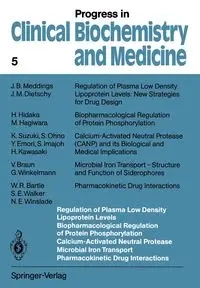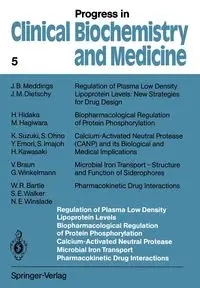Regulation of Plasma Low Density Lipoprotein Levels Biopharmacological Regulation of Protein Phosphorylation Calcium-Activated Neutral Protease Microbial Iron Transport Pharmacokinetic Drug Interactions - Bartle William R.
Regulation of Plasma Low Density Lipoprotein Levels Biopharmacological Regulation of Protein Phosphorylation Calcium-Activated Neutral Protease Microbial Iron Transport Pharmacokinetic Drug Interactions - Bartle William R.
EAN: 9783642729041
Marka
Symbol
298HGM03527KS
Rok wydania
2012
Strony
148
Oprawa
Miekka
Format
17.0x24.4cm
Redakcja
Bartle William R.
Język
angielski

Bez ryzyka
14 dni na łatwy zwrot

Szeroki asortyment
ponad milion pozycji

Niskie ceny i rabaty
nawet do 50% każdego dnia
Niepotwierdzona zakupem
Ocena: /5
Marka
Symbol
298HGM03527KS
Kod producenta
9783642729041
Rok wydania
2012
Strony
148
Oprawa
Miekka
Format
17.0x24.4cm
Redakcja
Bartle William R.
Język
angielski

Cholesterol is essential for normal cellular function. It is found in all cells of the body and is a major constituent of cell membranes. In addition, certain specialized tissues use cholesterol as the basic substrate
for the synthesis of more complicated sterols such as bile acids and the steroid hormones. Like most lipids cholesterol has a very low solubility in water. Therefore, in order for these molecules to be transported be tween
different organs of the body a series of lipid carriers known as lipoproteins has evolved. Over the last several years epidemiological evidence has accumulated suggest ing a strong relationship between the risk of
atherosclerosis and high plasma concen trations of one of these lipoproteins, low density lipoprotein (LDL) 1). Thus, in popula tions with high plasma concentrations of LDL-cholesterol a correspondingly high incidence of
vascular disease is seen. Since it has been demonstrated that reducing the steady-state plasma LDL-cholesterol concentration produces a proportional decrease in the risk of developing atherosclerosis 2), a major effort is now
underway to develop safe and effective lipid lowering agents. In the past, these efforts have been hampered by a lack of knowledge concerning the physiological regulation of the plasma LDL-cholesterol concentration. However,
recently there have been several major advances in these areas and it is now possible to precisely determine those factors that have the greatest effect on either increasing or decreasing the plasma LDL-cholesterol concentration.
EAN: 9783642729041
EAN: 9783642729041
Niepotwierdzona zakupem
Ocena: /5
Zapytaj o produkt
Niepotwierdzona zakupem
Ocena: /5
Napisz swoją opinię

